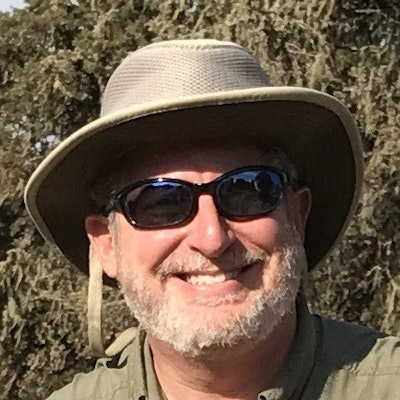
Question: What do airships, 747s, William Shatner, radiology, and giving back have in common? Answer: Rad-Aid International! Let me explain ...
A few years ago, I decided to bail out of the rat race of private practice radiology. My original goal was to retire altogether, but it seemed more reasonable to ease out slowly, maintain health insurance and some shred of income, and have something to do, at least periodically. And so I started out working 26 weeks per year, and now I'm down to 22 weeks. Which leaves 30 weeks that need to be filled.
I had originally thought I would ramp up my writing, but somehow that hasn't happened; in fact, my articles and blog posts have been fewer and further apart. Part of the problem is that my wife has insisted upon "for better or worse, but not for lunch," and so I've had to look for more to do outside the house.
It seemed wasteful to simply walk away from things radiological and nuclear, having trained extensively and practiced the trade for many, many years. But what could I do with this expertise? I wasn't about to go academic, and I didn't want to teach, at least not in the conventional sense.
In the midst of my musings, a pilot friend alerted me to an elaborate plan to convert a 747, then languishing in a Tucson, AZ, boneyard, into a flying hospital:
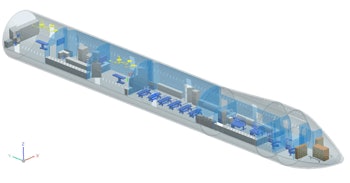 Image courtesy of Dr. Sam Friedman.
Image courtesy of Dr. Sam Friedman.I had strong opinions as to what imaging equipment absolutely had to be onboard, and I prepared to bombard the project with my recommendations.
Sadly, the 747 proved to be the wrong platform for this purpose, and the idea was ultimately scrapped, along with the airliner itself. (But don't despair, the concept will reappear in a few paragraphs.)
Having absolutely no idea how to make such things happen, but still wanting to do something this meaningful, and basically wanting to reinvent myself, I actually tried to contact actor William Shatner, of "Star Trek" fame, who had reinvented himself as a businessman and philanthropist. I figured he might have some advice. Ha. Naturally, he never wrote back. What a Klingon.
To boldly go ...
So my search for a meaningful postretirement existence continued. Ultimately, I wanted to do something with imaging, particularly with PACS and nuclear medicine. And through Merge (now an IBM company), I stumbled upon Rad-Aid. Merge, the PACS I knew best at the time (still true), had just partnered with Rad-Aid, and the picture snapped into focus for me. The announcement from September, 2015, tells that part of the story:
Merge Healthcare (NASDAQ: MRGE) today announced a new global collaboration with the nonprofit organization, Rad-Aid International, (US Registered 501c3) to bring vital radiology and health information technologies to medically underserved and poor regions of the world. The collaboration -- Rad-Aid Merge International Imaging Informatics Initiative (RMI4) -- leverages Merge's leadership in radiology information technologies with Rad-Aid's global health outreach network, including 3,500 volunteers, 14 country-outreach programs, 33 university-based chapters and affiliation with the United Nations' World Health Organization (WHO).
WHO reports that nearly half the world has little or no radiology services. Moreover, most of these low and middle-income countries have no access to health information technologies, such as Picture Archiving and Communication Systems (PACS), Electronic Health Records (EHR), Radiology Information Systems (RIS), Hospital Information Systems and other lifesaving health informatics platforms for storing, retrieving and interpreting patient data. In collaboration with Merge's charitable contributions of software, technical resources and expertise in radiology image management, Rad-Aid will implement these health information technologies at the nonprofit's partnered international sites along with Rad-Aid's ongoing delivery of clinical education, onsite training and radiology assistance to comprehensively support poor and resource-limited countries.
"This collaboration between Rad-Aid and Merge represents a major step forward in bridging charitable outreach and health technologies for the mission of improving global health," said Dr. Dan Mollura, chief executive officer, Rad-Aid International.
And there it was. I've since joined up with Rad-Aid and I've been on mission trips to Ghana and Tanzania, and I hope to keep traveling on their behalf as long as I can still tolerate the required shots and flying around the world in coach.
More about Rad-Aid
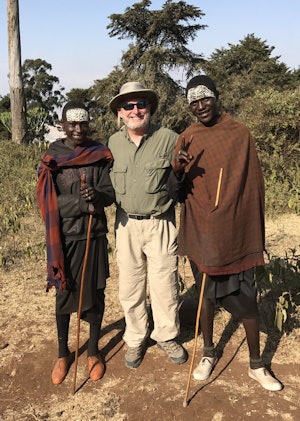 Dr. Sam Friedman and Masai friends in Tanzania. Image courtesy of Dr. Sam Friedman.
Dr. Sam Friedman and Masai friends in Tanzania. Image courtesy of Dr. Sam Friedman.I'll speak of my personal experiences shortly. First, you need to know a little more about Rad-Aid. Most of my information comes from its website and my friends among the incredible folks in charge, particularly Dr. Daniel Mollura himself.
I don't have to tell anyone about the vast improvements in medical care we've seen in the past several decades, due in no small part to the incredible power of medical imaging. But the advances we take for granted in the U.S. and Europe may be difficult to find in the developing world. And this is where Rad-Aid comes into the picture. The website states:
Rad-Aid began in 2008 to answer this need for more radiology and imaging technology in the resource-limited regions and communities of the world. The organization began as a few people at Johns Hopkins, and has grown to include more than 7,800 volunteers from 100 countries, 45,000 web visitors per year, 53 university-based chapter organizations, onsite programs in 20 countries, and an annual conference on global health radiology.
Rad-Aid's mission is to increase and improve radiology resources in the developing and impoverished countries of the world. Radiology is a part of nearly every segment of healthcare, including pediatrics, obstetrics, medicine and surgery, making the absence of radiology a critical piece of global health disparity.
I'm quite proud to be one of those volunteers.
Bringing underdeveloped nations up to world-class imaging standards is not as easy as it sounds, and it doesn't sound easy at all. Even if the funds exist to place a scanner on the ground in such a location, that's just the beginning. There must be infrastructure to keep the thing running, electricity, air conditioning, service, parts, and so on. And technologists need to be trained to operate it, and there must be enough radiologists around who are able to read what the machine produces. There are a hundred -- a thousand -- moving parts to this process. But if the magnificent technology that we take for granted is to come to the places where it is most needed, we have to start somewhere.
Rad-Aid begins this process with something called the Radiology-Readiness Assessment Tool. This is the heart of Rad-Aid and dictates how advanced imaging services will be introduced or enhanced at any particular site. The name says it all, really:
Radiology-Readiness is a data collection and analysis tool developed and trademarked by Rad-Aid in 2010, which has been endorsed and used by the World Health Organization since 2012. Radiology-Readiness is an instrument used by our volunteers and outreach teams for evaluating radiology infrastructure and planning an optimized radiology strategy that meets the healthcare needs of specific communities and facilities in resource-limited regions.
 Image courtesy of Rad-Aid.org.
Image courtesy of Rad-Aid.org.The survey asks some very hard questions, determining just how much technology a site can support and what will be done with the output. For example, is there adequate electrical power to support a CT or MRI? Are there drugs available to treat infections that might be found with a "simple" chest radiograph? These are questions we wouldn't even consider in the U.S., for example, but they help dictate what can be accommodated elsewhere.
Once the assessment is complete, Rad-Aid can drill down to the most optimal ways of bringing about change:
Once we conduct the Radiology-Readiness Assessment, we plan the project based on that data. [Then], we implement the project based on the plan whether it means installing hardware, configuring workstations, organizing training, writing research, or designing a new technology. ... Education is a central part of everything we do, and we hold training sessions so that Rad-Aid can train our in-country partners to use and maintain the implemented program. More importantly, we also receive training and education from our in-country partners so that we can learn from them about clinical and cultural factors that will influence the success of our collaborative program.
Lastly, we work with our in-country partners to analyze the results of the program, to find what worked and what did not work. In this way, we identify new challenges to face and find new resources to strengthen the program. Then, we return to step one and repeat our Radiology-Readiness Assessment so we can see how our project had a positive impact and what gaps need to be addressed. This circular iteration of data, analysis, planning, self-correction, and new data collection keeps Rad-Aid moving forward.
Rather like iterative reconstruction of an image, isn't it? Each pass yields better and better results.
As a "seasoned" volunteer, I can tell you this program works -- quite well, in fact.
My first trip took me to Korle Bu Teaching Hospital in Ghana, where my task was to help train residents and consultants (what we call attendings over here) in the use of their new PACS, donated by IBM/Merge, as you read a moment ago. I've been using PACS for something like 25 years, and there are many aspects that are second nature to us. Think about comparing the current and prior exams. You can do it with film, if you have enough view boxes, but with PACS, it's trivial -- if you know how to do it. Simply demonstrating the process of bringing up the prior alongside the exam to be read led to some huge grins and aha! moments. You cannot imagine the satisfaction of seeing the promise of soft-copy reading rediscovered, and assisting in the process.
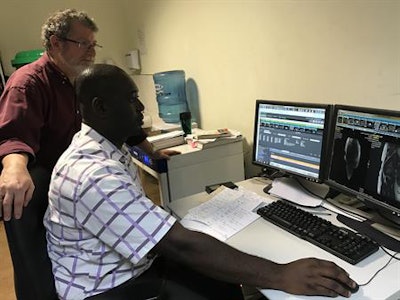 Working with PACS at Korle Bu Teaching Hospital in Accra, Ghana. Image courtesy of Dr. Sam Friedman.
Working with PACS at Korle Bu Teaching Hospital in Accra, Ghana. Image courtesy of Dr. Sam Friedman.I've just returned from my second trip, with the tremendous honor of receiving the Hyman-Ghesani Rad-Aid SNMMI Global Health Scholarship (in partnership with the Society of Nuclear Medicine and Molecular Imaging) for travel to the Aga Khan Hospital in Dar es Salaam, Tanzania. Rad-Aid's focus in Tanzania is on oncologic imaging and building diagnostic capacity in the cities of Arusha, Moshi, and Mwanza to create a band of interconnected institutions in northern Tanzania.
My task was to help improve nuclear medicine services, and frankly, I really just had to make the medical staff aware of how good the nuclear medicine department really is. Given the limitations of having to have a molybdenum/technetium generator flown in from South Africa every two weeks, having to share the only nuclear medicine physician in Tanzania with the hospital down the road, and having only one technologist who also serves as the physicist, radiation safety officer, radiopharmacist, nurse, and, occasionally, the janitor, I give this little department the highest marks. I did have the privilege of supervising Tanzania's first sentinel node procedure.
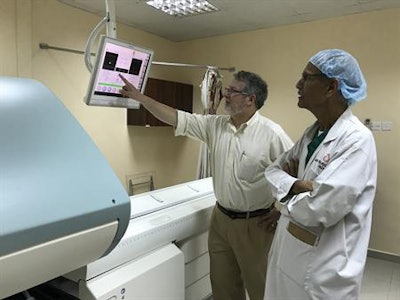 Reviewing sentinel node map with the chief surgeon at Aga Khan Hospital. Image courtesy of Dr. Sam Friedman.
Reviewing sentinel node map with the chief surgeon at Aga Khan Hospital. Image courtesy of Dr. Sam Friedman.I cannot wait for my next travel opportunity! With a bit of luck, I'll get the chance to return to Ghana and Tanzania, and perhaps visit other sites as well. We'll see what the future brings. I went to each nation knowing no one, but left many friends behind when I returned home. My wife probably didn't think the "for better or worse, but not for lunch" thing would evolve into me going to Africa for two weeks at a time!
Oh, yes -- below is an illustration of the flying hospital concept, a medical airship with advanced imaging onboard.
 Image courtesy of Rad-Aid and Straightline Aviation.
Image courtesy of Rad-Aid and Straightline Aviation.From the press release (do read it in its entirety):
Straightline Aviation today signed a memorandum of understanding with Rad-Aid to launch a humanitarian and philanthropic medical assistance program using Lockheed Martin's Hybrid Airship, uniting aircraft innovation with health technology for a new approach to global health outreach.
The Rad-Aid Straightline Medical Airship Program will deliver advanced radiology health services, diagnostic medical imaging equipment, and medical assistance to populations that are medically underserved, remote, or limited by poor access to conventional transportation infrastructure.
I wish I'd thought of that! An airship does indeed make much more sense than a 747, which gobbles fuel and needs a good-sized runway to take off and land. I'm hoping to be on the inaugural flight, whenever that may happen. (It might not be the USS Enterprise, but then I'm not Dr. McCoy, either. Hear that, Mr. Shatner?)
Making a difference
As medical professionals, we went into healthcare and medical imaging to make a difference. Rad-Aid offers the opportunity to do just that, and to give back in ways I could not have imagined. And so, I urge you, I beg you, I implore you -- go to the Rad-Aid website and sign up to be a volunteer. (And please consider donating to the cause as well. Bringing imaging to the world takes vast amounts of funding, and every little bit helps.)
Rad-Aid has literally hundreds of opportunities for everyone in imaging from physicians to medical students and residents, as well as radiologic technologists, sonographers, nurses, physician assistants, health physicists, and specialists in health IT and public health. If you have a radiologic skill, there's a place where you are needed. Trust me on that. You will help others, and you will grow as a person. Likely, you will learn more than you teach, but that's part of the process.
I mentioned the sentinel node procedure above, the first to be done in Tanzania. Think about it. Thanks to Rad-Aid, an old (not that old!) Jewish radiologist from the Deep South of the U.S. had the opportunity to go to Africa and help its citizens. As it turns out, the sentinel node patient and her husband were Muslim followers of the Aga Khan. They were very gracious, and they demurred when I thanked them for consenting to be the first to have this done in the country. In fact, the husband gave me what I consider the greatest compliment I have ever received in my career: "God has sent you here to help her." I cannot vouch for that, of course, but certainly Rad-Aid deserves the bulk of the credit.
This is the promise, the incredible potential of Rad-Aid. I urge you to be a part of it.
In addition to regular posts in the AuntMinnie.com PACS Community Forums, Dr. Friedman also maintains a blog at www.doctordalai.com. His observations and opinions are entirely his own.




















